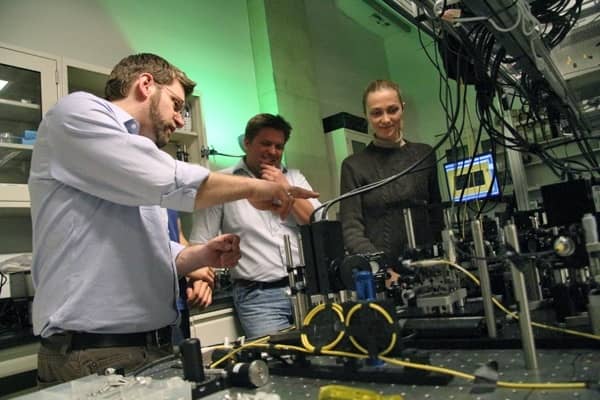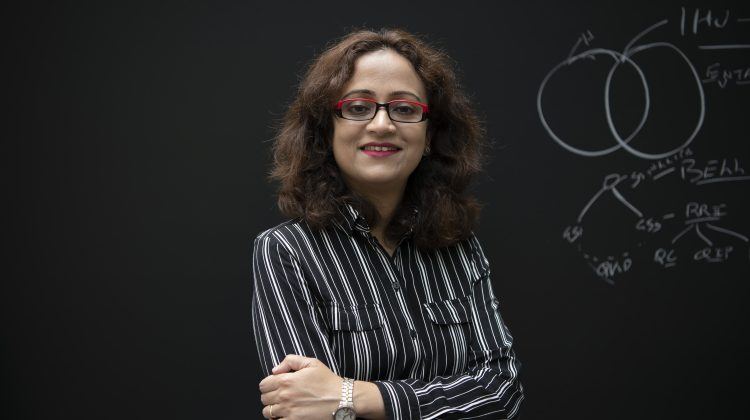Quantum Cause and Effect
Correlation does not imply causation – unless it’s quantum. That’s the message of surprising new work from Perimeter Institute and the Institute for Quantum Computing.

Does taking a drug and then getting better mean that the drug made you better? Did that tax cut really stimulate the economy or did it recover on its own? The problem of answering such questions – of inferring causal relationships from correlations – reaches across the sciences, and beyond.
Normally, correlation by itself does not imply causation. But new research from Perimeter Institute and the Institute for Quantum Computing (IQC) has found that in the case of quantum variables, it sometimes can.
The new work, just published in Nature Physics, is the result of a collaboration between Perimeter Faculty member Robert Spekkens, IQC Faculty member Kevin Resch, PhD student Katja Ried, MSc students Megan Agnew and Lydia Vermeyden, and Max Planck Institute senior research scientist Dominik Janzing.
As a practical illustration of the difference between correlation and causation, consider a drug trial: some people take a drug, and some of them get better. Even more promising, the doctors find that among people who took the drug, 60 percent recover; among people who didn’t take the drug, only 40 percent recover. What conclusions can the doctors draw?
At first blush, it may look as if the drug caused the recovery, but the doctors would need more information before drawing that conclusion. It might be that more men than women chose to take the drug, and more men than women tended to spontaneously recover. In that case, a common cause, gender, could potentially explain the correlation.
This imaginary drug trial shows how tricky it can be to distinguish cause-effect correlations from correlations springing from common causes. That’s why the caution “correlation does not imply causation” is drilled into the heads of every researcher for whom statistics is of even passing importance.
Over the last century, scientists, mathematicians, and philosophers have developed a powerful toolkit for untangling webs of cause, effect, and correlation in even the most complex evolving system. The case of systems with only two variables – like the drug trial above – turns out to be the hardest one.
If you want to avoid introducing assumptions about what’s happening, you need to intervene on variable A – in this case, taking the drug. That’s why a real drug trial would be carefully randomized, assigning some people to take the drug and others to take a placebo. Only active intervention on variable A can establish its causal relationship with variable B.
But what of quantum variables? This new research shows that certain kinds of quantum correlations do imply causation – even without the kind of active intervention that classical variables require.
The new research is both theoretical and experimental. Ried, Spekkens, and Janzing worked from the theoretical end. They considered the situation of an observer who has probed two quantum variables – say, the polarization properties of two photons – and found that they are correlated. The measurement is carried out at two points in time, but the observer doesn’t know if she’s looking at the same photon twice (that is, probing a cause-effect relationship) or looking at a pair of photons in an entangled state (that is, probing a common cause relationship).
The theorists’ crucial insight was that the correlations measured between a photon at one time and the same photon at another time had a different pattern than the correlations measured between two entangled photons. In other words, they discovered that, under the right circumstances, they could tell cause-effect from common cause.
Meanwhile, at the Institute for Quantum Computing, Agnew, Vermeyden, and Resch had the tools to put this remarkable idea to the test. They built an apparatus that could generate two entangled photons, A and B. They measured A, and then sent the pair through a gate that either transmitted photon A, or switched photon A and photon B and transmitted B.
Crucially, this gate could swap between the two scenarios, choosing one or the other based on the output of a random number generator. On the other side of this gate, the researchers conducted another measurement while blind to which photon they measured. Just as the theorists predicted, they saw two distinct patterns of correlation emerge.
This means that researchers measuring quantum variables can do something researchers measuring classical variables cannot: tell the difference between cause-effect and common cause in a system with only two variables, without making an active intervention on the first variable.
This discovery has significance for both quantum information and quantum foundations.
The work establishes a new class of things that quantum systems can do which classical systems cannot. It’s too early to say how that may play out, but such quantum advantages underpin the promise of quantum technologies: quantum entanglement, for instance, underlies quantum cryptography, and quantum superposition underlies quantum computation.
The discovery of new quantum advantages has historically led to interesting places, and the researchers are hopeful that this new quantum advantage will follow suit.
For those interested in quantum foundations, this work provides a new framework to ask basic questions about quantum mechanics. There is a lively and long-standing debate in the field concerning which quantum concepts are about reality, and which are about our knowledge of reality – for instance, whether the quantum uncertainty about (say) the polarization of a photon means that the photon itself has no defined polarization, or if it means that the observer of such a photon has limited knowledge.
Because correlations are about what observers can infer, while causal relations are about the physical relations among systems, this research opens a new window on such questions.
The team describes the work as opening the door to many more lines of inquiry, such as: How can these techniques be generalized to scenarios involving more than two systems? Is the menu of possible causal relations between quantum systems larger than between classical systems? And most broadly and excitingly: How should we understand causality in a quantum world?
– Erin Bow
FURTHER EXPLORATION






















































































